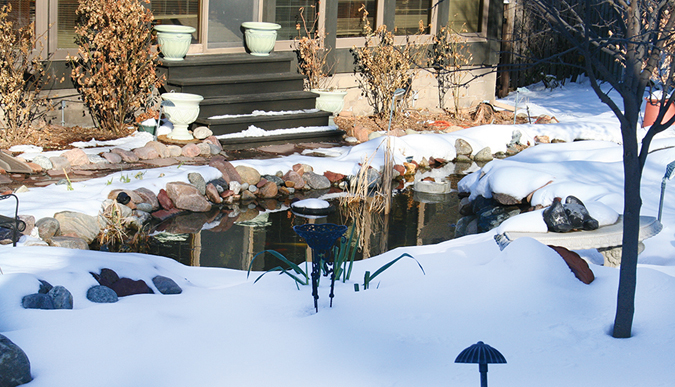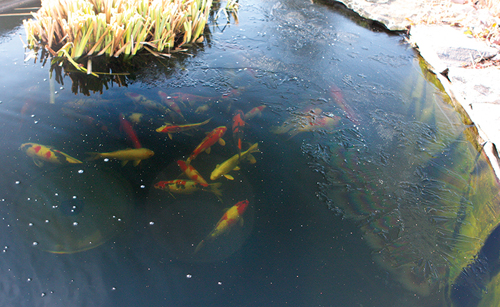
Just when I start to think that there isn’t much more can I write about keeping fish outside in brutally cold winters, I get a question that makes me realize that there are still some things I have not considered putting into writing before — even though I have been overwintering koi and goldfish outside in the northern Midwest for more than 35 years! There are many aspects to this topic, but it can be broken down into some basic principles — at least in my mind and, hopefully, in yours after reading this article.
I first want to recommend that you read the POND Trade article I wrote on this subject in August 2009 titled “Overwintering Koi Under Thick Ice,” click to read the article. This article generated a lot of interest in keeping fish outside where the temperature drops below 20 degrees Fahrenheit. It is very important to realize that the fluctuating extremes in water temperatures will be very stressful for your fish. While hardy fish like koi and goldfish adapt to these kinds of environments, they must be healthy going into winter, and their environment must offer the best conditions possible for them to survive in a healthy state with quality water that is well oxygenated.
There are many silent stressors during the winter that can eventually kill fish, such as diseases or parasites that may wait to show up until springtime. In any case, the factors that kill or stress even hardy fish under these conditions are many, and I will try to go through every one of them (at least the ones I can think of). Please remember that when it comes to living things and nature, there are always exceptions to every rule. Also, every pond is different due to hundreds of variables. I have to generalize when discussing these topics, but 98 percent of the time, this information is correct.
Aeration Above All

The lack of oxygen and a buildup of toxic gases is the No. 1 killer of an aquatic ecosystem. This includes fish, but also microbes, amphibians and invertebrates. Almost all the critters in your pond need oxygen. So, provide aeration, but in a way that the fish do not have to fight a current. You can provide circulation with a water pump that will aerate the water as long as you have an open surface in the ice. The open areas also allow toxic gases like hydrogen sulfide to escape. Aeration will drive off these gases as well. If your water pump is in a skimmer box, you are most likely running your stream. This is a dangerous situation if the power fails for any length of time, or if an ice dam forms in your stream. To keep it simple, just add an air pump with the aeration point in the center of a small pond, or with two or three points in large ponds. Running a water pump is a lot more expensive, and the intake can become plugged. Make sure to check the aeration points every day to determine that everything is working. Even a couple of days of without aeration can stress fish.
Some areas in a pond can become what I call dead zones. These are areas that your circulation does not reach and are therefore low in oxygen levels and high in toxic gases. These zones can kill quickly. During the winter, a fish’s metabolism can slow to the point that if they enter a dead zone, they might not have enough energy to swim out before being overcome. Proper pond design can prevent dead zones, but if you already have them, either keep the fish out of these areas or provide more aeration points.
Fluctuating Temperatures
A typical winter in areas that get really cold will see below-freezing temps for a period of time, allowing a layer of ice to form. Following a brief warmer period, which allows the ice to completely melt, it reforms again when temperatures plummet. This process is stressful for fish. Water temperatures can fluctuate 10 degrees or more overnight. There is not a lot you can do when Mother Nature does this, except to attempt to keep as much snow and ice on the pond as possible. Do not remove ice from the pond, and remember to unplug any heaters if you see a warm period predicted. A layer of ice keeps the water temperatures more stable. You also can create additional stress on the fish by shoveling on the surface or breaking up the ice. Fish become spooked easily, and you want them to be cozy and snug under that blanket of ice. Besides, it is a lot of work to remove chunks of ice and shovel off snow. You might mean well, but that ice serves a purpose that our fish have adapted to.
Water Changes
I started doing mid-winter water changes about 10 years ago, and it has seemed to help fish come out of winter more vigorous. By doing this, we are improving the quality of the water and thereby reducing stress. So, maybe two or three times during the winter, make a 10-percent water change. Of course, remove the chlorine as well, if present.
If salt is in your water, make as many water changes as possible before winter to get rid of the salt. Salt can lower the freezing point of water, and your water can become super cooled if salt is present.
Organic Loads

Decomposing leaves, rotting water plants or anything that has died in the water depletes the oxygen and is a huge stressor on the fish. Fish resting on top of rotting leaves for a long period of time can also develop a fungus infection on their bottom side. Fungus can grow into the gills of the fish, causing death. Even with a heavy layer of leaves and organics on the bottom, you can provide enough oxygen with heavy aeration and circulation. This will drive off the toxic gases and replace the oxygen that these decomposing items use up.
However, if the fish are fighting a current, they are forced to use energy that they cannot spare during the winter. A majority of the fish may survive in conditions like this, but it is still a stressor, and your best fish may die. We want a quiet environment for the fish. They need to feel snug and calm under that ice. So, remove leaves and the majority of these organics before the ice arrives.
Surface Stressors

Above-ground ponds are more difficult for overwintering fish. It really depends on how much of it is below ground. If the entire pond is on top of the ground, the pond needs to be emptied and the fish brought inside. If you have 2 or 3 feet of the pond below ground, overwintering fish can be accomplished. The soil surrounding a pond bottom provides an amazing heat source. A pond that is 30 inches below the soil line is deep enough here in the Midwest to overwinter hardy goldfish. However, koi need more depth, and I recommend a pond that is at least 40 inches deep. This depth provides the vertical strata that are necessary for the fish to develop their muscles normally. This also provides the earth’s warmth.
Most koi people that have expensive fish would not think about overwintering their fish where the ice forms on the surface. I completely understand this due to the risks posed by the many stressors. Fish of this caliber may need the extra protection of a structure over the pond or an indoor environment. However, providing aeration, limiting strong currents and removing salt and organics will result in successful fish keeping, even where there are brutally cold conditions. I would worry more about power outages and predators than the cold itself. Have faith in these techniques, and keep those stressors to a minimum.


